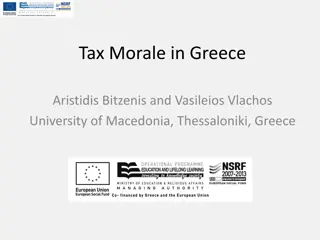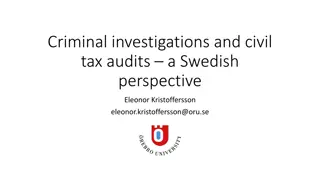Exploring Miguel de Cervantes: Writer, Soldier, Tax Collector, and Spy
Miguel de Cervantes was a multifaceted individual known for his works as a writer, soldier, tax collector, and spy. His literary creations such as "La Galatea," "Journey to Parnassus," and "The Travails of Persiles and Sigismunda" showcase his diverse talents and influences. Delve into the life and works of this influential figure who left a lasting impact on literature.
Download Presentation

Please find below an Image/Link to download the presentation.
The content on the website is provided AS IS for your information and personal use only. It may not be sold, licensed, or shared on other websites without obtaining consent from the author. Download presentation by click this link. If you encounter any issues during the download, it is possible that the publisher has removed the file from their server.
E N D
Presentation Transcript
CERVANTES CERVANTES WRITER, SOLDIER, TAX COLLECTOR AND SPY
https://www.google.com/maps/d/u/1/edit?mid=1VgO4gTxji5KKEdRiNiJArsLBO0BvP5Fv&ll=39.7https://www.google.com/maps/d/u/1/edit?mid=1VgO4gTxji5KKEdRiNiJArsLBO0BvP5Fv&ll=39.7 3261299542365%2C1.073593095676415&z=5 link to "The journeys of Cervantes"
Greek influence on Greek influence on the works of the works of Miguel de Cervantes Miguel de Cervantes
La Galatea La Galatea Was Miguel De Cervantes s first book, published in Under the guise of pastoral characters, it is an examination of love and contains many allusions to contemporary literary figures. The main characters of the Galatea are Elicio and Erastro, best friends and enamoured with Galatea. This work was inspired by the myth of Polyphemus and Galatea, and also from Daphnis and Chloe by the Greek writer Longus and by the Greek poet Teocritus, creator poetry. 1585. of ancient Greek bucolic
Journey to Parnassus Is a poetic work by Miguel de Cervantes. It was first published in 1614, two years before the author's death. It tells a literary journey by real and mythical geographies to mount Parnassus, in which Miguel de Cervantes, mounted on a mule and guided by the god Mercury embarks on the mission of recruiting the best Spanish poets to fight a battle against the mediocre poets. The work contains numerous biographical references of the life of Cervantes, as for example his participation in the battle of Lepanto.
The travails of Persiles and Sigismunda The travails of Persiles and Sigismunda Is the last book of Miguel de Cervantes and it was published in Madrid in 1617, a year after his death. Is a romance or Byzantine novel. Persiles Tule s prince makes a pilgrimage with Sigismunda, Frislandia s heir. They went from the north of Europe to Rome. Persiles and Sigismunda were in love and they were adventures including the kidnapping of Sigismunda by some barbarians. suffer countless Byzantine romance represents a revival of the ancient Greek romance of Roman times. Works in this category were written by Roman Empire during the 12th century. It work was inspired by Athiopica by Heliodorus. Byzantine Greeks of the Eastern
Greece in Don Quixote Greece in Don Quixote I.Some Greek myths in Don Quixote: The myth of the age of Man in Don Quixote The ancient myth of the races or ages of man, with a just and peaceful golden first age declining to that of iron as the moral behavior of man worsens. Don Quixote, in Cervante s book, searches for a return of the Golden Age, a sort of Utopia for him. Don Quixote, I, 11 Happy the age, happy the time, to which the ancients gave the name of golden
Greece in Don Quixote Greece in Don Quixote I.Some Greek myths in Don Quixote: Pyramus and Thisbe- Basilio and Quiteria Pyramus and Thisbe are two mythological characters which loved each other, but as their families didn t approve of their love, the end is tragic, getting them both killed in the end. Cervantes got inspired by this story in his story of Basilio and Quiteria, except in this one, the end is not tragic, in which Basilio fakes a deadly wound to marry Quiteria on his wedding day, and gets to marry her before he dies, but he doesn t.
Greece in Don Quixote Greece in Don Quixote II.Odysseus and Don Quixote, two traveling heroes They both travel around and the story is always focused on them. In this travels they find different adventures and obstacles which help them mature.
Greece in Don Quixote Greece in Don Quixote III.Chivalric novels set in Greece mentioned in Don Quixote Amadis de Grecia Written by Feliciano de Silva in 1530, it s a book of the Amadis de Gaula series, which talks of knight errantry. He was the favourite writer of Quixote. In the Amadis de Gaula series, another character appears from Greece called Rugel de Grecia. Belanis de Grecia A book written by Jeronimo Fernandez, and another of Quixote s favourite books.
Greece in Don Quixote Greece in Don Quixote The battle of Lepanto. In the book, a character referred to as the captive, tells Quixote his story, which includes his participation in the Battle of Lepanto, his capture by the Berbers and his escape from Argel. This character represents Cervantes, as he endured this adventures himself.
Don Quixote and Kazantzakis Don Quixote was one of Kazantzakis favourite literary characters as he shared his way of thinking and his way of living. Both main characters in the work, represented a half of Spain respectively, one being Quixote and the other Sancho Panza. In his book Spain he wrote a long poem dedicated to Quixote. . , . , .
Don Quixote poem of Kostas Ouranis Kostas Ouranis (Greek: , pen name of ; 1890 1953) acclaimed Greek poet, travel writer and journalist. was an , , , . , , , ... , , , , - ! . : !




![Town of [Town Name] Real Estate Tax Rates and FY 2024 Budget Summary](/thumb/62211/town-of-town-name-real-estate-tax-rates-and-fy-2024-budget-summary.jpg)


















